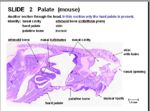Difference between revisions of "Hard Palate"
Jump to navigation
Jump to search
| Line 6: | Line 6: | ||
The hard palate (palatum durum) forms the rostral roof of the [[Oral Cavity Overview - Anatomy & Physiology|oral cavity]]. It merges caudally with the [[Soft Palate - Anatomy & Physiology|soft palate]] where a connective tissue aponeurosis replaces the bone. | The hard palate (palatum durum) forms the rostral roof of the [[Oral Cavity Overview - Anatomy & Physiology|oral cavity]]. It merges caudally with the [[Soft Palate - Anatomy & Physiology|soft palate]] where a connective tissue aponeurosis replaces the bone. | ||
| − | == | + | ==Structure and Function== |
*Bony shelf of palatine processes of the incisive, maxillary and palatine bones. Failure of the palatine bones to fuse results in cleft palate. | *Bony shelf of palatine processes of the incisive, maxillary and palatine bones. Failure of the palatine bones to fuse results in cleft palate. | ||
| Line 25: | Line 25: | ||
*keratinised stratified squamous epithelium | *keratinised stratified squamous epithelium | ||
| + | |||
==Species Differences== | ==Species Differences== | ||
| + | '''Herbivores''' | ||
*More heavily keratinised in herbivores | *More heavily keratinised in herbivores | ||
Revision as of 14:51, 7 July 2008
Introduction
The hard palate (palatum durum) forms the rostral roof of the oral cavity. It merges caudally with the soft palate where a connective tissue aponeurosis replaces the bone.
Structure and Function
- Bony shelf of palatine processes of the incisive, maxillary and palatine bones. Failure of the palatine bones to fuse results in cleft palate.
- 6-8 fixed transverse ridges to direct food caudally
- Flat
- Incisive papilla (small median swelling) behind incisive teeth
- Smaller papillae ducts branching to nasal cavity and veromeronasal organ
Histology
- Thick mucosa
- keratinised stratified squamous epithelium
Species Differences
Herbivores
- More heavily keratinised in herbivores
